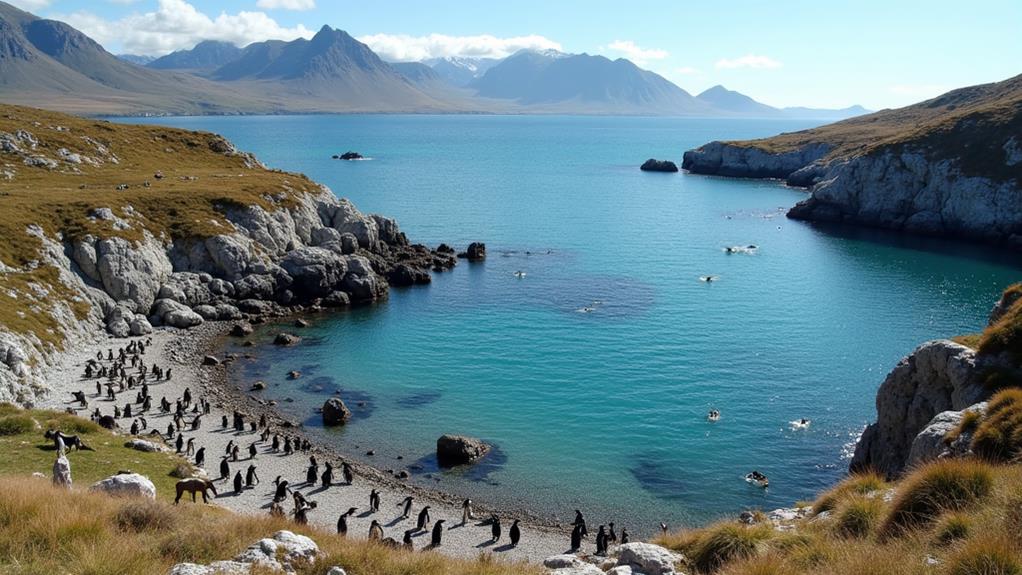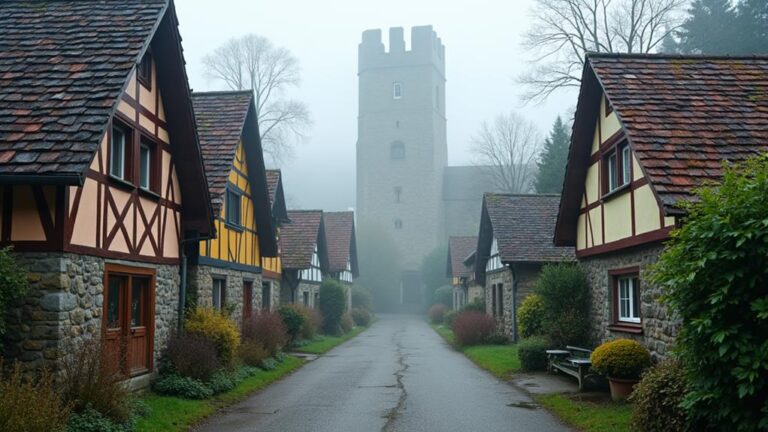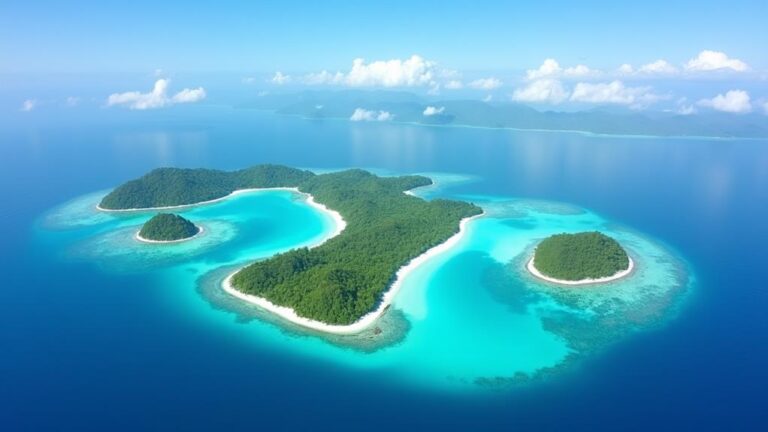Imagine standing on Argentina's windswept coast, the icy South Atlantic Ocean stretching out before you, as a group of Rockhopper Penguins emerge from the waves, their tuxedo-like feathers glistening with seawater. You've likely seen penguins before, but these charismatic birds are found nowhere else on Earth. Their distinctive crests and loud, high-pitched calls are just a few characteristics that set them apart. But as you watch them waddle and play, you can't help but wonder: what's behind the decline of these unique creatures, and what's being done to protect them in their Argentine habitat?
Contents
Key Takeaways
- No penguin species are found only in Argentina; however, Argentina is home to the largest breeding colony of Magellanic Penguins.
- Magellanic Penguins breed in large colonies on the coast and islands of Argentina, with an estimated population of over 1 million.
- Rockhopper Penguins are less common in Argentina and primarily inhabit the southern coast and the Falkland Islands (Islas Malvinas).
- Other penguin species, such as the Macaroni Penguin and the Chinstrap Penguin, can be spotted in Argentina but are not exclusive to the country.
- The unique combination of cold waters, strong winds, and abundant food sources makes Argentina's coastal regions ideal for penguin colonies.
Unique Penguins of Argentina
Observing penguin species in Argentina reveals a unique set of characteristics that set them apart from other penguin populations.
When you examine the physical traits of these birds, you'll notice distinct adaptations that have evolved to help them thrive in their environment.
One notable feature of Argentine penguins is their unique feathers, which serve as a vital component of their survival strategy. The feathers of Argentine penguins exhibit a distinctive structure, with a dense, tightly-packed arrangement that provides exceptional insulation.
This adaptation enables the birds to maintain a stable body temperature, even in cold water. Additionally, the feathers' unique shape and arrangement help to reduce drag, allowing the penguins to swim efficiently and conserve energy.
Penguin adaptations in Argentina have also led to the development of specialized feathers on their heads, which aid in the detection of prey.
These feathers are highly sensitive to vibrations in the water, enabling the penguins to locate prey in low-visibility conditions. By studying these unique feathers, you can gain a deeper understanding of the remarkable adaptations that have enabled Argentine penguins to flourish in their environment.
Habitat and Distribution
You'll find penguins in Argentina inhabiting coastal regions that offer suitable breeding and feeding conditions.
These regions often feature rocky shores, islands, or headlands that provide sheltered sites for breeding grounds, where you can find dense colonies of penguins.
Island colonies, in particular, are common in Argentina, with many species establishing large populations on isolated islands along the coast.
Coastal Regions
Numerous penguin species inhabit Argentina's coastal regions, with many found along the extensive coastline of Patagonia.
As you explore these coastal areas, you'll notice that penguins thrive in various habitats, including rocky shores, islands, and sandy beaches.
The unique combination of cold waters, strong winds, and abundant food sources makes these regions ideal for penguin colonies.
- Coastal erosion: Argentina's coastline is constantly changing due to erosion, which affects penguin habitats and breeding grounds. You'll observe how penguins adapt to these changes by relocating to new areas or adjusting their nesting sites.
- Marine pollution: Unfortunately, marine pollution is a significant threat to penguin populations in Argentina. As you visit these coastal regions, you'll notice the impact of pollution on penguin habitats and the importance of conservation efforts.
- Tidal patterns: Penguins in Argentina's coastal regions have adapted to the unique tidal patterns, which influence their feeding habits and breeding cycles.
- Ocean currents: The cold waters surrounding Argentina support a diverse range of marine life, which penguins rely on for food. You'll see how penguins exploit these ocean currents to feed on fish, krill, and squid.
Breeding Grounds
Argentina's diverse landscapes and climates support a wide range of penguin breeding grounds, from rocky shores to sandy beaches, each with its unique characteristics and advantages. As you explore these breeding grounds, you'll notice distinct nesting habits and colony dynamics.
| Breeding Ground Features | Penguin Adaptations |
|---|---|
| Rocky shores | Penguins use crevices and cracks to build nests, protecting themselves from predators and harsh weather. |
| Sandy beaches | Penguins dig burrows, often in large colonies, to escape extreme temperatures and reduce energy expenditure. |
| Islands with dense vegetation | Penguins use dense vegetation to build nests, providing camouflage and protection from predators. |
| Coastal cliffs | Penguins use ledges and overhangs to build nests, reducing accessibility to predators and competitors. |
Penguins in Argentina exhibit complex nesting habits, often returning to the same breeding grounds year after year. Colony dynamics also play a vital role in penguin breeding success, with large colonies providing increased protection and foraging opportunities. Understanding these breeding grounds and their characteristics is essential for managing and conserving penguin populations in Argentina.
Island Colonies
Among the diverse penguin breeding grounds in Argentina, island colonies are particularly notable for their unique habitat characteristics and distinct distribution patterns.
As you explore these island ecosystems, you'll notice the remote habitats are often characterized by rocky coastlines, sparse vegetation, and limited access to freshwater resources.
These island colonies provide a unique opportunity for penguins to thrive in isolation, with many species adapting to the local conditions.
You'll observe that the island ecosystems are shaped by the interactions between the penguins, their predators, and the available resources.
Some key features of island colonies in Argentina include:
- Island size and shape: Larger islands tend to support larger penguin colonies, while smaller islands may have more limited populations.
- Coastal morphology: The shape and structure of the coastline can affect the availability of breeding and nesting sites for penguins.
- Vegetation cover: Islands with more abundant vegetation may provide better protection from predators and harsh weather conditions.
- Marine productivity: The surrounding waters' productivity can impact the availability of food resources for penguins, influencing the size and stability of the colony.
Types of Argentine Penguins
When you examine the diverse penguin species found in Argentina, you'll encounter the Magellanic Penguin (Spheniscus magellanicus) and the Rockhopper Penguin (Eudyptes chrysocome).
These two species are distinct in their physical characteristics and habitats. You'll find that Magellanic Penguins are the most abundant in Argentina, while Rockhopper Penguins are less common and primarily inhabit the southern coast.
Magellanic Penguins
You're likely to encounter Magellanic Penguins in Argentina, as they're one of the most abundant penguin species found along its coast.
They breed in large colonies on the coast and islands of Argentina, with the largest colony located in Punta Tombo.
These penguins are highly social animals, often living in close proximity to one another.
During the breeding season, Magellanic Penguins are known to form large colonies, with individuals often returning to the same burrow year after year.
This behavior is a key aspect of their socialization, as it allows them to establish long-term pair bonds and reduce aggression between individuals.
When it comes to migration, Magellanic Penguins are known to make long journeys to reach their breeding and feeding grounds.
- They migrate up to 5,000 km (3,100 miles) each year to reach their breeding grounds.
- They're excellent swimmers, with some individuals reaching speeds of up to 25 km/h (15.5 mph).
- Magellanic Penguins feed on a variety of fish, squid, and krill.
- They're listed as Near Threatened on the IUCN Red List, due to declining populations and habitat degradation.
Rockhopper Penguins
While Magellanic Penguins dominate the Argentine coast, another penguin species, the Rockhopper Penguin, can also be found in the country's southern regions.
You'll recognize Rockhoppers by their distinctive characteristics, including crests, red eyes, and red-orange beaks. They're the smallest penguin species in Argentina, reaching heights of about 22 inches and weighing up to 8 pounds.
Rockhoppers are social birds, often living in large colonies on rocky islands.
Their behavior is characterized by loud, high-pitched calls, which they use to establish territories and attract mates. You'll notice that Rockhoppers are excellent swimmers, feeding on krill, squid, and fish in the South Atlantic Ocean.
They're also skilled divers, capable of reaching depths of up to 100 feet.
In Argentina, Rockhoppers breed on the Falkland Islands (Islas Malvinas) and the coast of Tierra del Fuego.
They're listed as vulnerable due to declining populations, mainly caused by climate change, overfishing, and oil spills.
Conservation efforts are underway to protect Rockhopper habitats and reduce human impact on their populations.
Threats to Penguin Populations
Habitat destruction and degradation pose significant threats to penguin populations in Argentina.
As you explore the challenges faced by these iconic birds, it becomes clear that human impact is a major contributing factor. Climate change, in particular, exacerbates the issue by altering the delicate balance of their ecosystem.
You'll notice the effects of these threats in the following ways:
- Habitat fragmentation: The destruction of habitats due to human activities such as mining, fishing, and construction has led to the fragmentation of penguin colonies, making it difficult for them to find suitable breeding and feeding grounds.
- Food scarcity: Climate change has altered the distribution and abundance of penguin prey, making it harder for them to find food and sustain their populations.
- Increased energy expenditure: Changes in sea ice coverage and temperature have forced penguins to expend more energy to find food and shelter, leading to malnutrition and starvation.
- Breeding disruptions: Human impact and climate change have disrupted the breeding patterns of penguins, leading to reduced reproduction rates and population decline.
Conservation Efforts in Place
Argentina's penguin populations face numerous challenges, but conservation efforts are underway to mitigate the effects of human impact and climate change.
As you consider the plight of these iconic birds, recognizing the significance of community engagement in shaping conservation strategies is vital. Local communities are working closely with researchers to monitor penguin populations, identify key habitats, and develop effective conservation plans.
By engaging with local residents, conservationists can better understand the complex relationships between human activities and penguin populations, ultimately informing more effective conservation policies.
Government policies also play a critical role in protecting Argentina's penguin populations. The Argentine government has established several protected areas, including national parks and wildlife reserves, which provide a safe haven for penguins to breed and feed.
Additionally, laws regulating fishing practices and coastal development have been enacted to minimize the impact of human activities on penguin habitats. By combining community engagement with effective government policies, Argentina is taking an exhaustive approach to conserving its penguin populations and ensuring the long-term survival of these charismatic birds.
Best Places to Spot Penguins
You're likely enthusiastic to catch a glimpse of these charismatic birds in their natural habitat.
As a result, Argentina has become a popular destination for penguin tourism. Penguin watching is a significant contributor to the country's economy, and numerous sites have been developed to facilitate this activity.
When planning your trip, consider the following locations for ideal penguin spotting:
- Península Valdés: A UNESCO World Heritage Site, this peninsula is home to a large colony of Magellanic penguins.
- Cabo Dos Bahías: Located in the Argentine Patagonia, this site provides a prime setting for observing penguins in their natural habitat.
- Isla Escondida: This island is a protected area, and its remote location makes it a perfect spot for penguin watching.
- Estancia San Lorenzo: A private nature reserve, this site offers guided tours for penguin enthusiasts.
When engaging in penguin tourism, it's crucial to respect these birds' habitat and follow guidelines set by local authorities to minimize the impact on their environment.
Protecting Argentina's Penguin Heritage
To promote heritage preservation, consider the following guidelines for penguin tourism:
| Conservation Measure | Impact on Penguins | Tourist Action |
|---|---|---|
| Maintain safe distance | Reduces stress and disturbance | Stay at least 10 meters away from penguins |
| Respect breeding areas | Protects vulnerable chicks | Avoid entering marked breeding areas |
| Dispose of waste properly | Prevents pollution and harm | Use designated waste disposal sites |
Frequently Asked Questions
Can Penguins Drink Saltwater From the Ocean?
You might wonder if penguins can drink saltwater from the ocean. They possess a saltwater adaptation, a gland above their eyes that filters excess salt, allowing them to drink ocean water, exploiting ocean chemistry.
Do Penguins Have Knees Under Their Feathers?
You're examining feather anatomy, and it's natural to wonder, do penguins have knees under their feathers? In reality, penguins' leg structure is unique, with knees hidden under feathers, actually located higher up under their bodies.
Are Penguins Able to Fly at High Altitudes?
Can you soar with penguins in mind? You'll find they're not built for high-altitude flight. Their wing shape, more suited for diving, and flying habits, characterized by short, low-altitude bursts, limit their aerial capabilities.
Can Penguins Eat Fish With Bones in Them?
You might wonder if penguins can eat fish with bones in them. Research suggests penguins can consume fish with bones due to their robust digestive system, which efficiently breaks down fish skeletons and facilitates bone digestion.
Do Penguins Have Unique Fingerprints Like Humans?
Unraveling the mysteries of avian identity, you'll find that, just like humans, penguins have unique fingerprint patterns. Researchers use digital identification to analyze these patterns, making each penguin's mark distinct, aiding in species tracking and study.
Conclusion
As you've 'driven' through the world of Argentina's penguins, you've seen the impact of human activities on their populations. Like the 'gas gauge' on a car, their numbers are running low. To guarantee the future of these unique birds, it's vital to persist with conservation efforts to 'refuel' their populations. By supporting organizations that work to protect their habitats and combat threats, you can help safeguard the long-term survival of these unique birds. Argentina's penguin heritage depends on it.









